
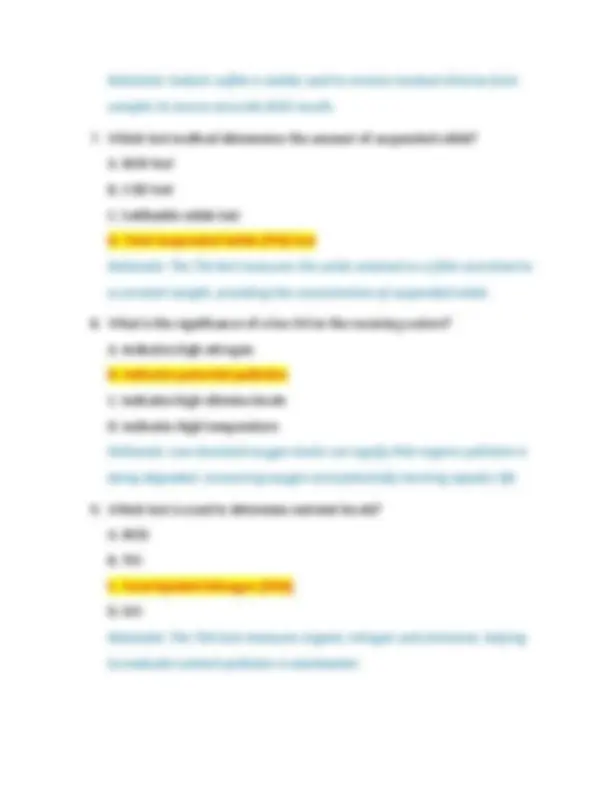
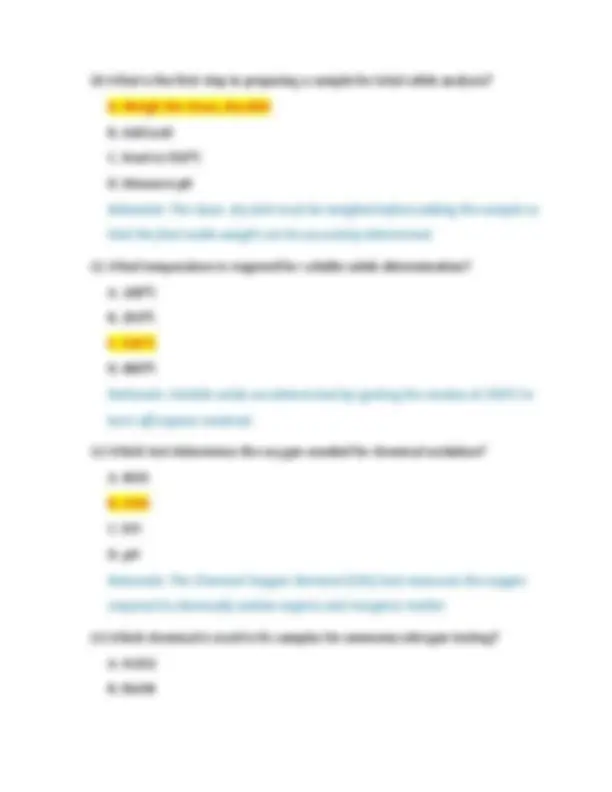
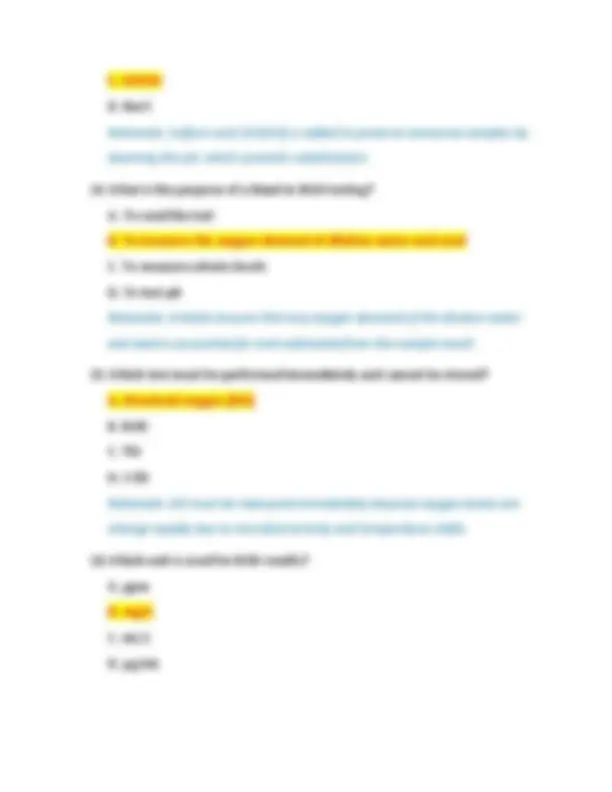
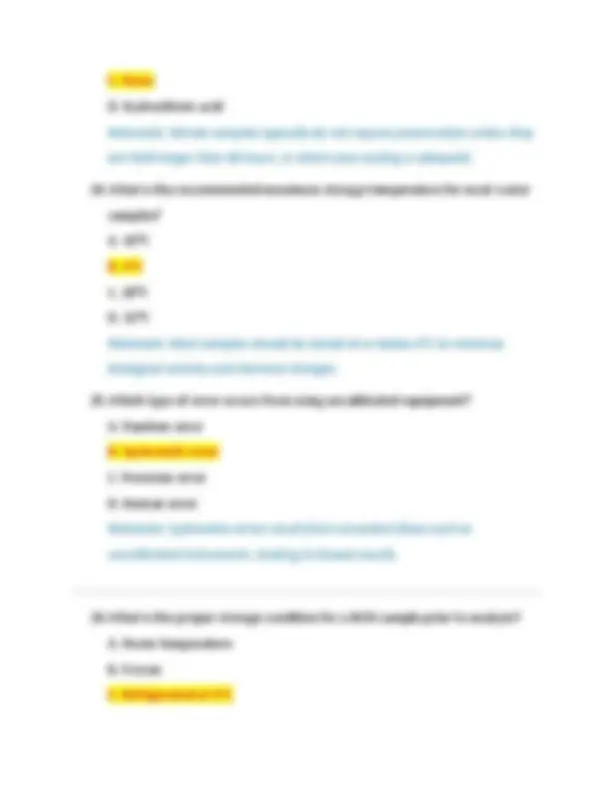

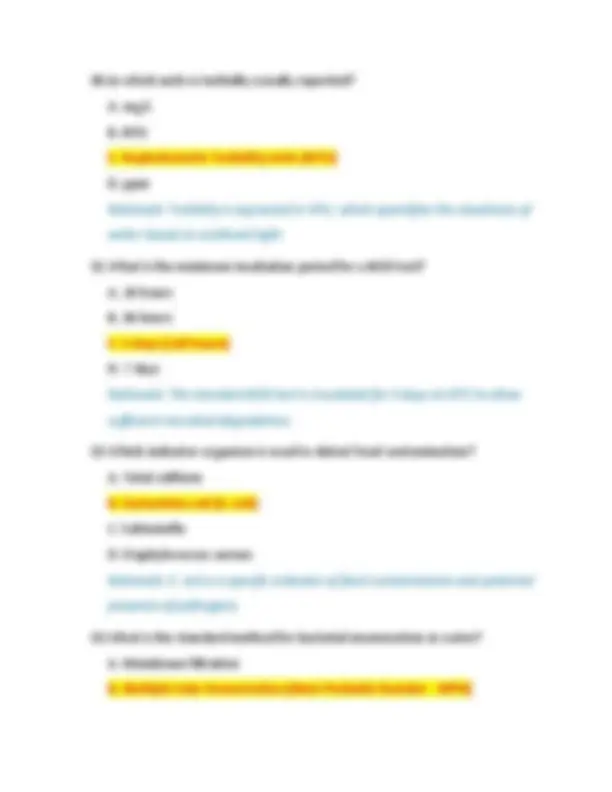
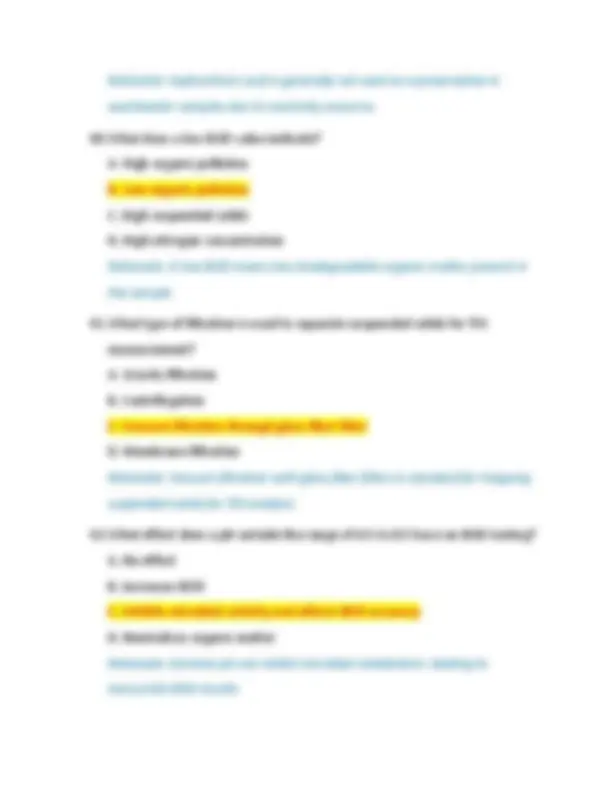
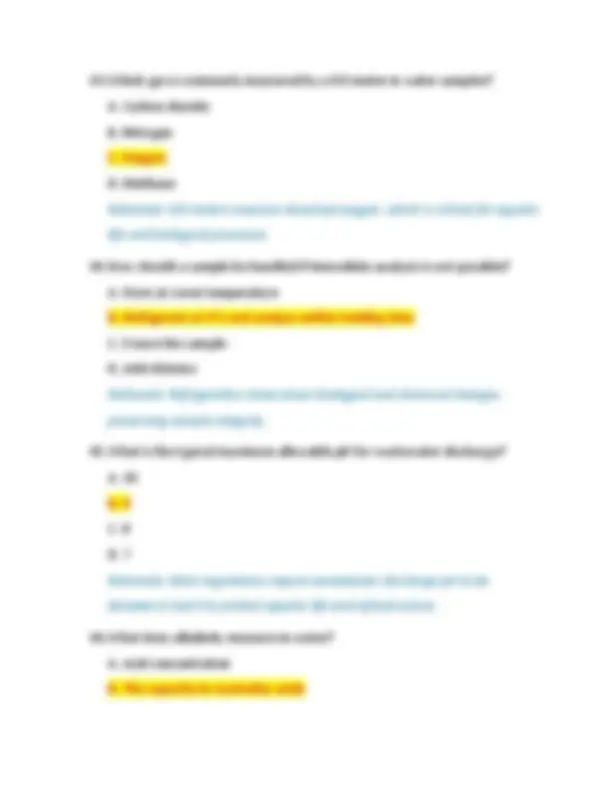
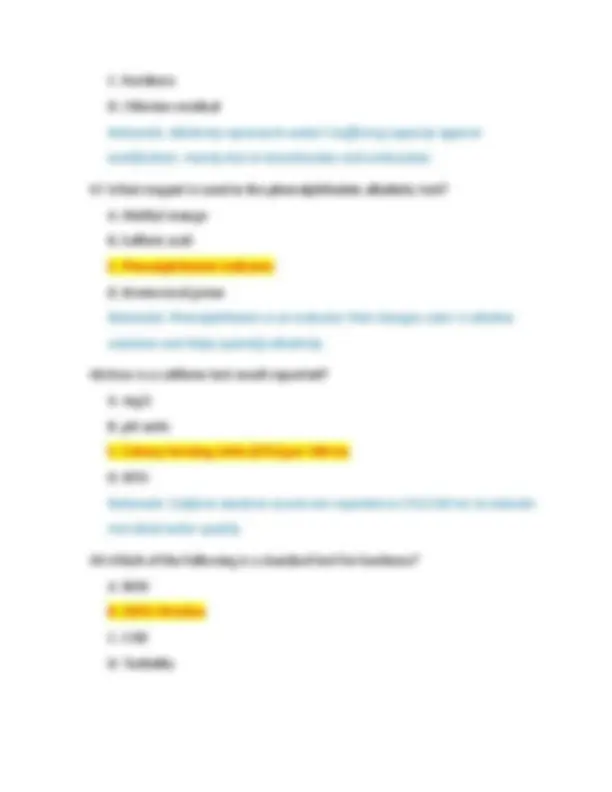

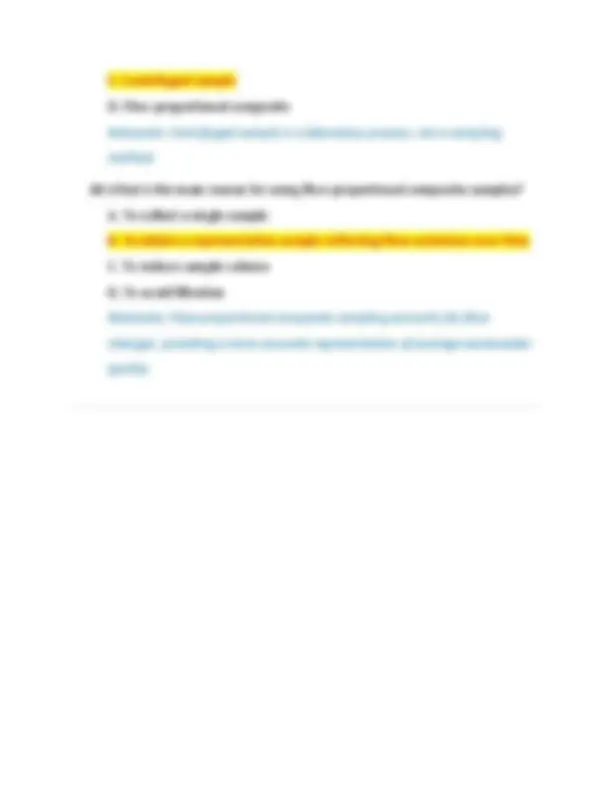


Study with the several resources on Docsity

Earn points by helping other students or get them with a premium plan


Prepare for your exams
Study with the several resources on Docsity

Earn points to download
Earn points by helping other students or get them with a premium plan
Community
Ask the community for help and clear up your study doubts
Discover the best universities in your country according to Docsity users
Free resources
Download our free guides on studying techniques, anxiety management strategies, and thesis advice from Docsity tutors
CWEA GRADE 1 LAB ANALYST EXAM ACTUAL EXAM 200 QUESTIONS AND CORRECT DETAILED ANSWERS WITH RATIONALES |AGRADE
Typology: Exams
1 / 19

This page cannot be seen from the preview
Don't miss anything!












C. 12 hours D. 48 hours Rationale: According to Standard Methods, BOD samples should be analyzed as soon as possible, but the maximum holding time is 48 hours when stored at ≤4°C.
10.What is the first step in preparing a sample for total solids analysis? A. Weigh the clean, dry dish B. Add acid C. Heat to 550°C D. Measure pH Rationale: The clean, dry dish must be weighed before adding the sample so that the final solids weight can be accurately determined. 11.What temperature is required for volatile solids determination? A. 100°C B. 250°C C. 550°C D. 800°C Rationale: Volatile solids are determined by igniting the residue at 550°C to burn off organic material. 12.Which test determines the oxygen needed for chemical oxidation? A. BOD B. COD C. DO D. pH Rationale: The Chemical Oxygen Demand (COD) test measures the oxygen required to chemically oxidize organic and inorganic matter. 13.Which chemical is used to fix samples for ammonia nitrogen testing? A. H2O B. NaOH
D. NaCl Rationale: Sulfuric acid (H2SO4) is added to preserve ammonia samples by lowering the pH, which prevents volatilization. 14.What is the purpose of a blank in BOD testing? A. To seed the test B. To measure the oxygen demand of dilution water and seed C. To measure nitrate levels D. To test pH Rationale: A blank ensures that any oxygen demand of the dilution water and seed is accounted for and subtracted from the sample result. 15.Which test must be performed immediately and cannot be stored? A. Dissolved oxygen (DO) B. BOD C. TSS D. COD Rationale: DO must be measured immediately because oxygen levels can change rapidly due to microbial activity and temperature shifts. 16.Which unit is used for BOD results? A. ppm B. mg/L C. mL/L D. μg/mL
20.Which parameter must be controlled during a BOD incubation? A. Light exposure B. Chlorine levels C. Temperature D. Alkalinity Rationale: The BOD bottles must be incubated at a controlled temperature of 20°C ± 1°C to ensure standard conditions for microbial activity. 21.What is the purpose of a DO probe? A. To measure nitrates B. To measure BOD directly C. To measure dissolved oxygen D. To measure solids Rationale: A DO probe is an electrochemical sensor used specifically to measure dissolved oxygen in liquids. 22.What type of glassware is used for BOD testing? A. Beaker B. Flask C. BOD bottle D. Test tube Rationale: BOD bottles are specially designed to prevent gas exchange, ensuring accurate DO depletion measurements. 23.What preservative is used for nitrate samples? A. Sodium sulfite B. Sulfuric acid
C. None D. Hydrochloric acid Rationale: Nitrate samples typically do not require preservation unless they are held longer than 48 hours, in which case cooling is adequate. 24.What is the recommended maximum storage temperature for most water samples? A. 10°C B. 4°C C. 20°C D. 32°C Rationale: Most samples should be stored at or below 4°C to minimize biological activity and chemical changes. 25.Which type of error occurs from using uncalibrated equipment? A. Random error B. Systematic error C. Precision error D. Human error Rationale: Systematic errors result from consistent flaws such as uncalibrated instruments, leading to biased results. 26.What is the proper storage condition for a BOD sample prior to analysis? A. Room temperature B. Frozen C. Refrigerated at 4°C
30.In which units is turbidity usually reported? A. mg/L B. NTU C. Nephelometric Turbidity Units (NTU) D. ppm Rationale: Turbidity is expressed in NTU, which quantifies the cloudiness of water based on scattered light. 31.What is the minimum incubation period for a BOD test? A. 24 hours B. 36 hours C. 5 days (120 hours) D. 7 days Rationale: The standard BOD test is incubated for 5 days at 20°C to allow sufficient microbial degradation. 32.Which indicator organism is used to detect fecal contamination? A. Total coliform B. Escherichia coli (E. coli) C. Salmonella D. Staphylococcus aureus Rationale: E. coli is a specific indicator of fecal contamination and potential presence of pathogens. 33.What is the standard method for bacterial enumeration in water? A. Membrane filtration B. Multiple tube fermentation (Most Probable Number - MPN)
C. Gram staining D. Turbidity measurement Rationale: The MPN method estimates bacterial populations using multiple tubes and statistical tables. 34.What is the purpose of acidifying a sample for metal analysis? A. To neutralize alkalinity B. To increase pH C. To preserve the sample by preventing metal precipitation D. To disinfect Rationale: Acidification prevents metal ions from precipitating and adheres to container walls, keeping them in solution for analysis. 35.What should be done if a sample for nitrate analysis contains chlorine residual? A. Filter the sample B. Heat the sample C. Dechlorinate the sample D. Adjust pH to alkaline Rationale: Chlorine interferes with nitrate analysis and must be neutralized before testing. 36.Which instrument is used to measure absorbance in spectrophotometry? A. Turbidimeter B. Spectrophotometer C. pH meter D. DO meter
Rationale: Hydrochloric acid is generally not used as a preservative in wastewater samples due to reactivity concerns. 40.What does a low BOD value indicate? A. High organic pollution B. Low organic pollution C. High suspended solids D. High nitrogen concentration Rationale: A low BOD means less biodegradable organic matter present in the sample. 41.What type of filtration is used to separate suspended solids for TSS measurement? A. Gravity filtration B. Centrifugation C. Vacuum filtration through glass fiber filter D. Membrane filtration Rationale: Vacuum filtration with glass fiber filters is standard for trapping suspended solids for TSS analysis. 42.What effect does a pH outside the range of 6.5 to 8.5 have on BOD testing? A. No effect B. Increases BOD C. Inhibits microbial activity and affects BOD accuracy D. Neutralizes organic matter Rationale: Extreme pH can inhibit microbial metabolism, leading to inaccurate BOD results.
43.Which gas is commonly measured by a DO meter in water samples? A. Carbon dioxide B. Nitrogen C. Oxygen D. Methane Rationale: DO meters measure dissolved oxygen, which is critical for aquatic life and biological processes. 44.How should a sample be handled if immediate analysis is not possible? A. Store at room temperature B. Refrigerate at 4°C and analyze within holding time C. Freeze the sample D. Add chlorine Rationale: Refrigeration slows down biological and chemical changes, preserving sample integrity. 45.What is the typical maximum allowable pH for wastewater discharge? A. 10 B. 9 C. 8 D. 7 Rationale: Most regulations require wastewater discharge pH to be between 6 and 9 to protect aquatic life and infrastructure. 46.What does alkalinity measure in water? A. Acid concentration B. The capacity to neutralize acids
Rationale: EDTA titration is a complexometric method used to quantify water hardness (calcium and magnesium ions). 50.Why is deionized water used in laboratory testing? A. It contains minerals B. It is less acidic C. It is free of ions that could interfere with test results D. It is cheaper than tap water Rationale: Deionized water is purified to remove ions that might contaminate or skew analytical results. 51.What is the purpose of performing a calibration curve in spectrophotometric analysis? A. To clean the instrument B. To relate absorbance to concentration C. To measure turbidity D. To test pH Rationale: A calibration curve establishes the relationship between known concentrations and their absorbance, enabling unknown sample quantification. 52.Which parameter is measured using the Winkler method? A. BOD B. COD C. Dissolved oxygen D. pH
Rationale: The Winkler method is a classic titrimetric method used for measuring dissolved oxygen in water samples. 53.What is the effect of turbidity on chlorine disinfection? A. Enhances disinfection B. Shields microorganisms, reducing effectiveness C. Has no effect D. Reduces pH Rationale: High turbidity protects microorganisms from chlorine, reducing disinfection efficiency. 54.What is the role of buffer solutions in pH meter calibration? A. To clean the electrode B. To provide known pH values for calibration C. To dechlorinate samples D. To dilute samples Rationale: Buffer solutions with known stable pH values are essential for accurate pH meter calibration. 55.What is the typical concentration range for a standard nitrate calibration curve? A. 0-1 mg/L B. 0-50 mg/L C. 50-100 mg/L D. 100-200 mg/L Rationale: Calibration curves for nitrate analysis commonly cover the 0 to 50 mg/L range to capture typical sample concentrations.
C. Centrifuged sample D. Flow-proportional composite Rationale: Centrifuged sample is a laboratory process, not a sampling method. 60.What is the main reason for using flow-proportional composite samples? A. To collect a single sample B. To obtain a representative sample reflecting flow variations over time C. To reduce sample volume D. To avoid filtration Rationale: Flow-proportional composite sampling accounts for flow changes, providing a more accurate representation of average wastewater quality.